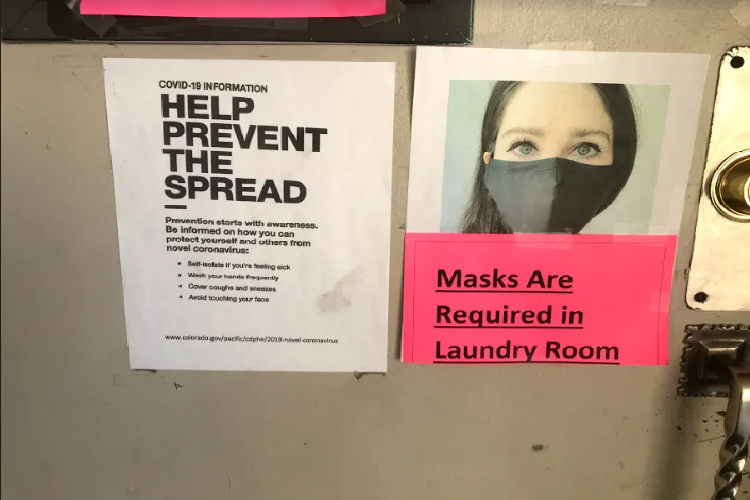
A message is posted in front of a laundry room requiring masks to enter. photo by David Lopez-Vences
As the holiday season starts to arrive, the cases of COVID-19 are rising at an alarming rate.
For months now, the process of dealing with COVID has been exhausting for everybody. The constant worry for one’s loved ones or even for one’s own health can put a strain on anybody’s mental health, especially when everybody isn’t taking it as seriously as possible. With procedures in place for everybody’s safety, it seems these are still not being followed. As a result, the number of cases in Colorado seem to be increasing drastically in time for the holiday season, creating a rising risk when it comes to leaving the house.
Amy Gelinas, a senior scientist for Somalogic, is working on developing reagents that bind the SARS-CoV-2 spike protein. She described them as aptamers, “which are short, single-stranded pieces of modified DNA that in many ways can function like an antibody.” The reagents that Gelinas is developing can be used for a “rapid diagnostic test.” Gelinas stated, “Much like a pregnancy test, or for therapeutics, they could block the spike protein on the coronavirus from binding the ACE2 receptor on human cells, thus preventing the virus from getting into cells and replicating.” The aptamers she is working with have several advantages compared to antibodies: their size allows them to possibly penetrate the surface of the virus better than antibodies and the ease of synthesizing helps with reproducibility. These aptamers also can be stored in most temperatures for long periods of time. To top it all off, the aptamers are made in labs without animals.
Gelinas’ work surrounding the coronavirus is remarkable. The aptamers she is developing can help save so many lives. Unfortunately, while these are still being developed, many lives are at stake due to the amount of misconceptions in the public. One important misconception that Gelina pointed out was about testing. “There are essentially three different types of tests and they are not interchangeable, as they are really meant to be used at different stages of infection.” These misconceptions surrounding testing range from many things. Online, people may post about being positive in one nostril and negative in the other. Of course, this type of comment can lead people to believe that there is an inconsistency in testing, creating a lack of trust in the scientific community. Clarification is needed in order to get everybody back to being safe.
The three different types of testing Gelinas helped clarify were the Polymerase Chain Reaction (PCR) test, the antigen test, and the antibody test. Gelinas commented, “The PCR test is the gold standard, and if there is any viral material in the sample, it will be detected.” It’s important to realize that the test is only as good as the sample. If there is a high amount of virus it will clearly come back as positive. If there is a very small amount of virus it will most likely come back as negative. This is where the misconception comes into play. The example of one nostril testing positive and the other testing negative does not make a test unreliable. This type of testing focuses on if the virus is present. Sadly, the virus can still be undiscovered during this type of testing, depending on the amount detected, which is where the other types of testing come in. The antigen test helps detect a protein made by the virus quickly. Gelinas added, “These tests are useful for triaging sick patients who come into the hospital, as they work best when some are near the peak of infection.” The antigen test is the fastest of the three, usually taking minutes to get results. However, it is still slightly unreliable due to the false negativity rate. The last type of testing, being the antibody test, helps determine if a person has ever had COVID. Gelinas insisted that “this test should not be used as a diagnostic. So, the takeaway is people need to know what type of test is appropriate for a given situation and evaluate the results accordingly.”
When asked about the rising amounts of cases in Colorado, Gelinas pointed out a few key reasons, one being how people are over staying inside all the time. She stated, “People are just tired of being cooped up and not living their normal lives, the so-called COVID fatigue.” This is one of the primary reasons why the amount of cases are going up. Higher amounts of people are going out, which increases the intake and helps create more positive cases. Of course going out is understandable, but when it’s for the wrong reasons it causes a lot of frustration. Parties, large social gatherings, and irresponsible actions cause a lot of harm. To add on, leaders contradicting one another help with mass confusion. For example, a president not wearing a mask and stating outrageous misinformation conflicts with the scientific community urging people to wear masks and to stay home. These mixed messages from leaders contribute to things such as people not wearing masks, people going out, and of course not listening to anybody. These basic guidelines to surviving a pandemic safely are all being ignored by many, and it’s showing with the rising cases we’re seeing now. The rising risk we’re seeing now is too extreme to ignore. Lastly, Gelinas said, “I would urge everyone to follow the CDC guidelines regarding appropriate and safe behavior.”